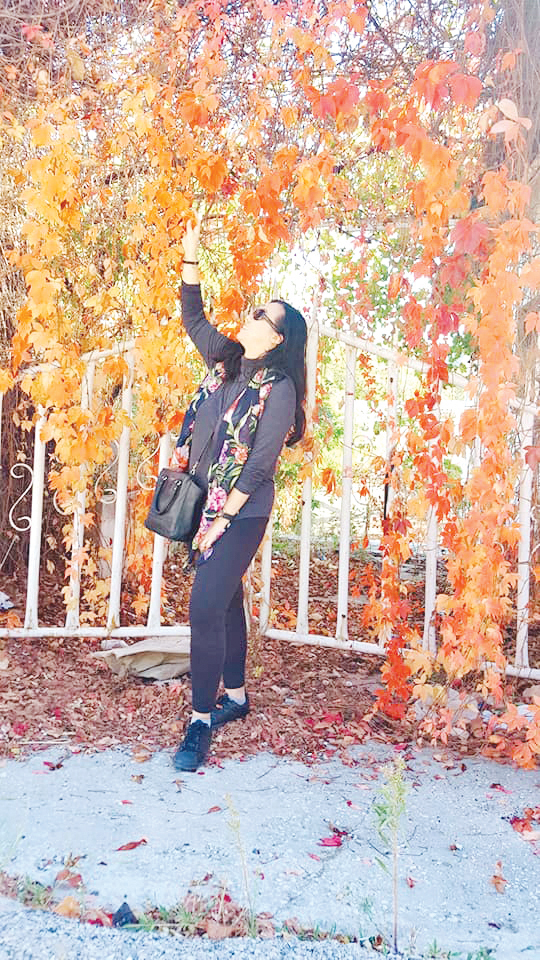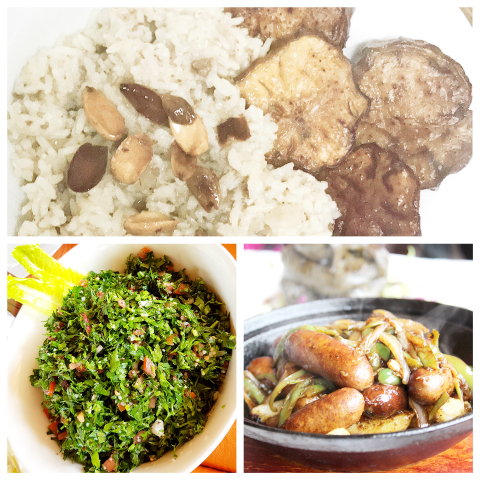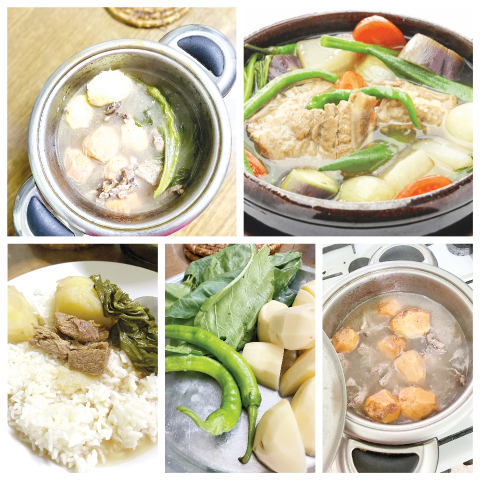Making sinigang in Syria
Recreating the Filipino classic in a war-torn country
At A Glance
- During one of my mother-in-law's visits to our house, she said she found some rare yellow guavas in the market. I was ecstatic when I got a kilo of the sweet-smelling fruit!
By Jellyn Gueco

in war-torn Syria
Six years ago, I left my glamorous life in Dubai and moved to a warzone.
I know that this line sounds like the beginning of an explosive action movie that one would probably expect to see on Netflix but, believe it or not, I’m talking about my real life here.
In 2017, I packed my bags and decided to settle down in my husband’s home country, Syria, proclaimed at that time as the most dangerous country on Earth. Nobody really believed I was going to go through with the move. My friends would constantly scratch their heads in confusion and ask me why I would give up my career and my life in Dubai. But I remember that, at that time, I had the optimism of a five-year-old. After all, it was not the first time I would travel to this country.
The first time I visited Syria was in 2008, right after my wedding in Cyprus. We landed in Damascus and then traveled to the coastal city of Lattakia, where my husband’s family lives. I was a bundle of nerves because I was about to meet the entire clan.
Fortunately, the anxiety was short-lived. Everyone was welcoming. Our vacation was a whirlwind of house visits and introductions. I felt like my in-laws were parading me to the entire city, the exotic wife from the “Filipin,” who snagged their first-born child. I remember them oohing and aahing. I remember relatives asking me why I looked Chinese and not brown. I remember acquaintances comparing me to the handful of Filipinos they would often see on Sundays at the local Catholic church.

I remember going into local boutiques to shop for a new wardrobe because the clothes I brought from Dubai could not stand the November cold. My naïve 25-year-old self only packed summer dresses and swimsuits because I mistakenly thought that Mediterranean beaches would be swimmable all year, like Boracay or Puerto Galera. My in-laws bought me pricey leather boots and a jacket that, in all honesty, made me feel Robin Padilla-esque.
Since I wanted to be the ideal daughter-in-law, I wore my new outfits anywhere and everywhere we went. I remember wearing the same leather jacket as I toured the ruins of the ancient city of Ugarit, where one of the oldest alphabets in the world, the Ugaritic alphabet, originated in 1400 BC.

I remember feeling starved because lunch did not start until three in the afternoon. I was baffled because people would siesta for a couple of hours even on weekdays before the city would come alive again around 6 p.m. I wondered why there were no beggars on the streets. Crimes were also uncommon and everyone felt safe. I remember how my mother-in-law would confidently take me for a walk at half-past midnight to do another round of family visits.

What I liked about Lattakia circa 2008 was how idle and comfortable life seemed to be. Don’t get me wrong, it was a bustling city with concrete buildings, yellow taxis, and people everywhere. Unlike Dubai, the lunches were longer, the people were calmer, and work was not the center of their lives. I remember telling my husband that Lattakia was such a lovely place. We were thinking then that, perhaps, after five more years in Dubai, it would be our next permanent home.
But that did not happen.
In 2011, the Syrian civil war broke out. Year after year, we waited for the war to end but it never did. Every time we planned to visit, my husband’s family told us it was not safe.
It was not until the summer of 2017 that we decided to jump the gun and make the move back to Syria. It was almost 10 years since I last stepped into the country and I did not know what to expect. I was leaving a comfortable life behind and starting a new chapter in the unknown. For the first time in my life, I was not sure what was waiting for me, for us.
Lattakia welcomed me again with open arms—not as a tourist, but as a resident. During the first few weeks, I went through the motions of reacquainting with friends and family, engaging in small talks over unending cups of qahwe, a traditional Arabic coffee that was too bitter for my Nescafé-loving palate. In between plates of a grassy-tasting parsley salad called tabbouleh and rolled vine leaves named yalangi, I smiled and powered through hours of Arabic conversations I barely understood.

As I went around the city, I noticed that Lattakia was very much different from the place I visited the first time. It was grittier, noisier, and overall, much grayer than I remembered. The blue skies and idyllic afternoons were overshadowed by the stench of adversity. While there was forced enthusiasm in the air, it was hard to miss the vestiges of war. It was a city that survived and still trying to survive the blowbacks of armed conflict.
But that was okay.
I knew I was coming back as a different person as well.
I was no longer the starry-eyed, eager-to-please young bride with a promising career back in Dubai. The past 10 years tested me, made me more cynical, and somehow, molded me into a much stronger person. Yes, there were still doubts but I was walking into the fire with my eyes wide open, ready for anything. May it be bombs or butterflies, I was all in.
This time, since I was not just passing through, I vowed to immerse myself in the Lattakian lifestyle. One of the things I made an extra effort to learn is how to cook traditional Syrian dishes. With my Kapampangan roots, cooking was hands-down one of my favorite things to do.
Learning to cook Syrian dishes, however, was not only for my enjoyment but also for survival. I could not revert to my trusty adobo and sinigang mixes when I wanted to whip up something quick. Unlike in most countries around the world, there were no Asian or Filipino groceries in Lattakia. Finding Kikkoman soy sauce or pork in the shops was a rare feat. There was no sampaloc or gabi in the fresh market to make my favorite soup dish. Because of this, I figured I had to learn how to cook with local ingredients and make the most of what was available.
One of the first Syrian dishes I learned is Maqluba, an upside-down eggplant and rice dish that, if my husband is to be believed, I now cook better than anyone in his family does. It took me countless hours watching my husband’s grandmother and numerous attempts in the kitchen before perfecting that dish.
Slowly, I started adding more local dishes to my arsenal—molokhia, fattet jaj, shish barak, and more. Each dish took me days, weeks, and sometimes, even months to master. My neighbors would always marvel at my ingenuity in learning how to cook all of these dishes, sometimes saying how I could be a much better cook than other Syrian women. With every dish I learned to cook, I felt more embedded into Syrian culture. I guess food has a way of doing that to a person.
If life was a cooking show, I would probably come out on top.
But unfortunately, life is not just all about food.
Living in Syria has its challenges.
I admit I struggled to make friends in Syria. Not a lot of women my age spoke fluent English and those who did were not so friendly. For years, I had no friends I could invite for coffee or just gossip with randomly. A girls’ shopping trip meant going to the souq (market) with my mother-in-law and ladies’ nights would be me having buza (ice cream) with my husband’s younger cousin, who is almost half my age.
Traveling outside of the country also proved to be a challenge. Because it was fairly easy for me to travel from Dubai to Lattakia, I did not realize that traveling to other countries from Syria would be so complicated. There were also electricity problems, gas shortages, and financial sanctions, not to mention the routine missile attacks that would hit Syria almost every week.
And then, Covid-19 happened.
If there was one thing that frustrated me about the pandemic, it made it tougher for me to see my family in the Philippines. It was already difficult and expensive to travel from Syria pre-Covid, and it became extra challenging with the Covid-19 restrictions in place.
Call it strange but sometimes, I would wake up craving the taste of lechon or crispy pata, and I would feel disappointed knowing I could not do anything about it. It may sound shallow but these things were constant reminders of what I was missing. I was yearning for the sight, the smell, and the taste of home. I had not seen my Mama, my siblings, and the rest of my family for over six years. While life in Syria had been kind to me, I still longed for the warm embrace of my loved ones from the Philippines.

in war-torn Syria
So when I had the opportunity to cook one of my favorite childhood dishes, I felt inexplicable joy. During one of my mother-in-law’s visits to our house, she said she found some rare yellow guavas in the market and asked if I wanted some. I was ecstatic when I got a kilo of the sweet-smelling fruit! I was already imagining the flavor of one of my favorite dishes that I had not tasted for a long time—sinigang sa bayabas. But when the small plastic bag arrived, I belatedly realized I had no idea what to do with the guavas. Do I peel the fruits? Slice? Mash? Puree? Or do I just dump them with the beef ribs and be done with it? Never had I ever cooked this dish without the ever-reliable Sinigang Mix.
Without the help of Mama Sita, I called my very own Mama instead for reinforcements. She talked me through the process via a video call and guided me as I added green sili, spinach (instead of kangkong), and potatoes (instead of gabi). I was surprised to learn that it was a simple one-pot dish and it was not much harder than using a flavoring packet.
As the soup started simmering, the familiar smell of sinigang wafted through the air. Coupled with my mom’s nagging not to let the guavas melt too much, the aroma was oddly comforting. Somehow, I was not as homesick anymore. As I savored the first spoonful of the sinigang, I realized I could still create a piece of home anywhere I went.
It’s been almost five months now since my husband and I moved to the Philippines but our time in Syria remains close to my heart. It taught me that no matter where we are in our lives, there is always something new to learn and a unique flavor waiting to be discovered.